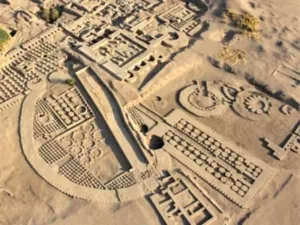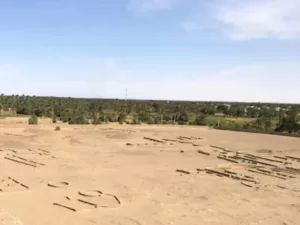When we think of ancient civilizations of the Nile, most of us immediately picture the grand pyramids and temples of Egypt. But another powerful kingdom thrived along the banks of the great ancient Egyptian Nile river. The one whose legacy has been overshadowed by its more famous neighbour. This was the kingdom of Kerma, an ancient African civilization that flourished for over a millennium, from around 2500 BCE to 1500 BCE. Yet despite its impressive achievements in art, architecture, trade, and governance, Kerma remains to be discovered too many.
This article aims to rectify that oversight by taking a closer look at this forgotten civilization’s history, culture, and impact. By the end, we want to show that Kerma was not simply a footnote in Nile Valley history but a rich and distinctive culture that deserves to be celebrated and remembered.
The Geography and History of Kerma

Kerma was located in what is now modern-day Sudan, on the east bank of the ancient Nile River. It is around 550 kilometres south of modern-day Cairo, Egypt. This kingdom emerged as a powerful political and economic force around 2500 BCE, roughly contemporary with the early dynastic period of ancient Egypt.
Like many civilizations on the Nile River, Kerma’s economy was based on agriculture. It also had a solid cattle-raising tradition and trade in luxury goods such as gold, ivory, and exotic woods.
Kerma’s capital city was located at the site of modern-day Kerma, known in ancient times as Dukki Gel or Doukki Gel. It was a sprawling city with a complex urban layout, including a royal palace, temples, public buildings, and residential neighbourhoods.
Unlike ancient cities on the Nile, which were built of stone, many of Kerma’s buildings were mud-brick and timber. It has made the preservation of archaeological sites more challenging.
Kerma’s Relationship with Ancient Egypt

One of Kerma’s most important relationships was with Ancient Egypt, which lay to the north along the Nile. Over the centuries, the two civilizations had a complex and evolving relationship. It ranged from trade and diplomacy to conflict and conquest.
At first, the relationship between Kerma and Egypt was one of trade and cultural exchange. Archaeological evidence shows that the two civilizations traded goods, such as gold, ivory, and enslaved people, and ideas like religion, art, and architecture. For example, with their elaborate architecture, Kerma’s royal tombs may have influenced the development of the pharaonic tombs of Ancient Egypt.
Similarly, Egyptian motifs, such as the sphinx and the lotus flower, appear in Kerma’s art and material culture. Interestingly, the history of Kerma shares some parallels with the story of the sunken city of Heracleion, which was also a major trading hub and cultural centre that was ultimately lost to the sea. Additionally, some have drawn comparisons between Kerma and the mythical lost city of Atlantis, which was said to have been a powerful civilization that met its downfall in a catastrophic event.
However, as both civilizations grew in power and influence, their relationship became more complicated. In the Middle Kingdom period of Ancient Egypt (c. 2055-1650 BCE), Egyptian pharaohs began to expand southward into Nubia.
Sometimes using military force to establish their dominance over the region. Kerma, yet, was not quickly subdued. Its armies, fortified cities, and sophisticated military tactics made it a formidable opponent. The two kingdoms engaged in several wars over control of the Nile Valley.
Despite these conflicts, there were also periods of peaceful coexistence and cultural interchange. For example, the New Kingdom period of Ancient Egypt (1550-1070 BCE) saw a revival of trade and diplomacy between Kerma and Egypt.
The pharaohs of the 18th dynasty, such as Hatshepsut and Thutmose III, sent expeditions to Nubia to establish trade relations. They bring back exotic goods. They also built temples and monuments in Nubia, some of which bear inscriptions in Egyptian and Meroitic, the language of the Kerma kingdom.
The Rise and Fall of the Kerma Kingdom

The early Kerma Kingdom was centred around the city of Kerma, which served as its political, economic, and religious capital. The city was strategically located where the Nile River turned sharply to the east. It created a natural bottleneck that allowed the Kerma people to control river traffic and trade.
Over time, the Kerma Kingdom expanded its control over a vast territory. It encompassed much of modern-day Sudan and parts of Egypt, Eritrea, and Ethiopia. The kingdom’s influence extended along the Nile Valley and into the Red Sea region. In these regions, Kerma traders maintained contact with the civilizations of the Arabian Peninsula and beyond.
Despite the many achievements of the Kerma Kingdom, it faced significant challenges from neighbouring states, particularly the expanding Egyptian empire.
Around 1500 BCE, the Kerma Kingdom was conquered by the armies of Egypt’s New Kingdom. They had developed powerful military technology and tactics. Despite fierce resistance, the Kerma forces were defeated, and their capital city of Kerma was sacked and burned.
After its defeat, the Kerma Kingdom was incorporated into the Egyptian empire as a vassal state. Its culture and institutions were largely assimilated into the dominant Egyptian civilization.
The Architecture and Art of Kerma

The geographical location and interactions with neighbouring cultures of Ancient Egypt influenced the kingdom’s art and architecture.
The kingdom’s capital city, Kerma, was surrounded by a massive wall up to 10 meters high and 5 meters thick in some places. One of Kerma’s most distinctive architectural features is its monumental architecture. It includes large mud-brick structures and fortified walls. The Western Deffufa, a three-story mud-brick structure, served as a temple or palace within the city. The Western Deffufa’s distinctive stepped design and decorated facades are among the most iconic examples of Kerma architecture.
Kerma is also known for its funerary architecture, particularly the tumuli or burial mounds that dot the landscape. These mounds could reach up to 30 meters. These were used to bury royalty and high-ranking officials. The mounds were constructed of layers of mud bricks and filled with various grave goods, including pottery, jewellery, and weapons. Some of the most impressive examples of Kerma tumuli are in the cemetery at Kerma.
Kerma’s Legacy: Influences on Later African Civilizations
Although the ancient kingdom of Kerma declined and was absorbed by the expanding civilization of Ancient Egypt,
its legacy continued to influence later African civilizations for centuries. The kingdom’s distinctive cultural and artistic traditions and strategic location along the ancient Nile Valley impacted the region’s history.
One of the most significant ways Kerma influenced later African civilizations was through architecture. These later civilizations built versions of the Western Deffufa and other monumental structures. They often incorporate Kerma style and design elements.
Kerma’s funerary architecture, particularly its distinctive tumuli or burial mounds, also had a lasting impact. The tradition of building tumuli continued in Nubia and other parts of Africa long after the decline of Kerma. Similar burial mounds are found in the Sahara and the Horn of Africa cultures.
Kerma’s artistic traditions also influenced later African civilizations. The distinctive black and red geometric designs of Kerma pottery, for example, can be seen in the pottery of Meroe and other Nubian cultures.
The legacy of Kerma and other Nubian kingdoms played a vital role in the Pan-African movement of the 20th century. It sought to reclaim and celebrate the cultural heritage of Africa. Most importantly, Kerma’s legacy as a powerful and independent African kingdom inspired later generations to resist colonialism and assert their cultural identities.

